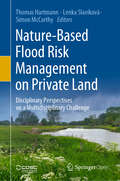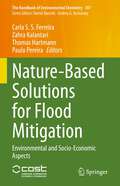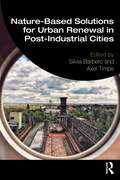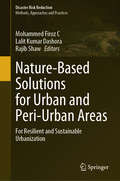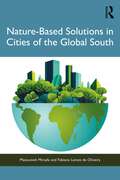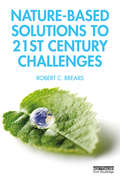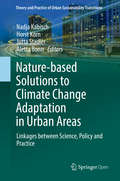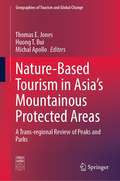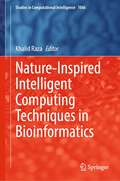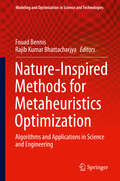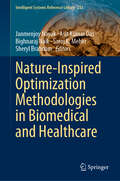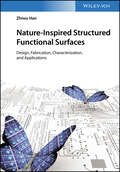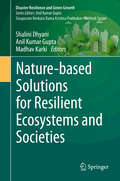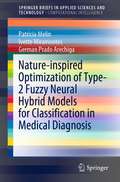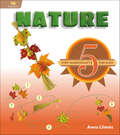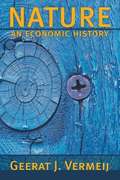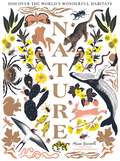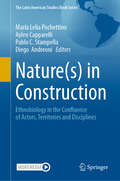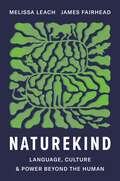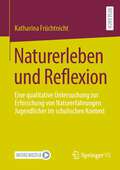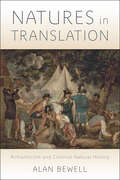- Table View
- List View
Nature-Based Cities: Performance-Driven Design Approaches for Climate Change Adaptation (Digital Innovations in Architecture, Engineering and Construction)
by Katia Perini Francesca MoscaThis book introduces a groundbreaking approach to urban design, addressing site-specific challenges arising from the impacts of climate change. It provides an overview of the most relevant climate change impacts and related adaptation strategies, aligning with sustainable development goals. Nature-based solutions (NBS) are some of the most significant adaptation strategies, yet the book addresses the lack of quantitative approaches for their design. A design approach and related methodology that can be used by designers with different levels of complexity is presented, discussing its applicability and limitations according to selected key performance indicators and related thresholds. Such methodology and the related tools are applied to case studies with a focus on the performance of NBS in improving thermal comfort (microclimate regulation) and reducing flooding risks (stormwater retention). A final workflow for a coupled performance-driven design approach is presented for readers, offering a pathway to define design strategies based on site-specific key performance indicators. The target audience includes practitioners, urban designers and planners, researchers, and anyone interested in urban environment design, nature-based solutions, and computational approaches to sustainable design.
Nature-Based Flood Risk Management on Private Land: Disciplinary Perspectives on a Multidisciplinary Challenge
by Thomas Hartmann Lenka Slavíková Simon McCarthyThis open access book addresses the various disciplinary aspects of nature-based solutions in flood risk management on private land. In recent decades, water management has been moving towards nature-based solutions. These are assumed to be much more multi-purpose than traditional “grey infrastructures” and seem to be regarded as a panacea for many environmental issues. At the same time, such measures require more – and mostly privately owned – land and more diverse stakeholder involvement than traditional (grey) engineering approaches. They also present challenges related to different disciplines. Nature-based solutions for flood risk management not only require technical expertise, but also call for interdisciplinary insights from land-use planning, economics, property rights, sociology, landscape planning, ecology, hydrology, agriculture and other disciplines to address the challenges of implementing them. Ultimately, nature-based flood risk management is a multi-disciplinary endeavor. Featuring numerous case studies of nature-based flood risk management accompanied by commentaries, this book presents brief academic reflections from two different disciplinary perspectives that critically highlight which specific aspects are of significance, and as such, underscore the multi-disciplinary nature of the challenges faced.
Nature-Based Solutions for Flood Mitigation: Environmental and Socio-Economic Aspects (The Handbook of Environmental Chemistry #107)
by Thomas Hartmann Paulo Pereira Carla S. S. Ferreira Zahra KalantariThis book provides an overview of the typical nature-based solutions (NBS) used for flood mitigation at different scales and in different areas (e.g. from catchment to hillslope scale; from urban to coastal areas). NBS can provide several ecosystem services, such as water regulation and water quality enhancement, and as such offer relevant technical solutions to complement typical grey infrastructures to mitigate flood hazard and water quality problems. In recent years, political awareness and interest from the scientific community have led to increasing implementation of NBS worldwide. In light of this trend, this book provides valuable insights into the environmental aspects of NBS, particularly their effectiveness for flood and pollution mitigation, and discusses socio-economic aspects related to the implementation of NBS, including regulatory aspects, cost, and citizens’ perceptions of NBS. Compiling the latest research, the book furthers our understanding of the role of NBS for flood mitigation and its relation to environmental aspects, to guide scientists and stakeholders in future NBS projects. It is intended for the scientific community and stakeholders, such as spatial planners and landscape managers.Chapter "Nature-based solutions for flood mitigation and resilience in urban areas" is available open access under a Creative Commons Attribution 4.0 International License via link.springer.com.
Nature-Based Solutions for Urban Renewal in Post-Industrial Cities
by Silvia Barbero Axel TimpeThis book, based on the experiences and insights gained during the Horizon 2020 project proGIreg, offers a detailed overview of targeted nature-based solutions and their impacts on various key sustainability areas, guiding readers through the spatial analysis, co-design, and implementation processes of cities in Europe and Asia. Chapters shed light on the challenges and opportunities encountered in each location, including Germany, Italy, Croatia, Bosnia and Herzegovina, Greece, Portugal, Romania and China. It also shares essential lessons learned and a wide range of indicators crucial for assessing the benefits of nature-based solutions on social innovation, circular economy, biodiversity, and health. Finally, the focus of this book shifts to the future of nature-based solutions as catalysts for new and green community economies as well as policies aimed at addressing climate change and urban renewal. The lessons and insights from the projects highlighted in this book will be valuable for urban planners and policymakers worldwide, as well as for a broader audience interested in nature-based solutions and urban regeneration.The Open Access version of this book, available at www.taylorfrancis.com, has been made available under a Creative Commons CC-BY 4.0 license.
Nature-Based Solutions for Urban and Peri-Urban Areas: For Resilient and Sustainable Urbanization (Disaster Risk Reduction)
by Rajib Shaw Mohammed Firoz C Lalit Kumar DashoraThis book explores the concept of nature-based solutions (NbS) as a sustainable approach to tackle the environmental challenges in urban and peri-urban areas such as biodiversity loss and urbanization in the changing climate. The book highlights the myriad benefits of NbS, including enhancing resilience, mitigating urban heat island effect, promoting biodiversity, and improving air and water quality. Drawing on real-world case studies from different global contexts, the book provides practical examples of successful NbS implementation in various urban and peri-urban settings. Through an interdisciplinary lens, the book discusses the science, policy, and governance aspects of NbS, emphasizing the need for collaboration among stakeholders, policymakers, and communities to effectively implement the solutions. It will also explore the economic benefits of NbS and how they can contribute to the well-being and social equity of urban populations. The book serves as an essential guide for policymakers, researchers, and practitioners seeking sustainable and nature-centric approaches to address the environmental challenges that cities and peri-urban areas face in the twenty-first century.
Nature-Based Solutions in Achieving Sustainable Development Goals: Harmonizing Nature and Progress
by Pardeep Singh Prateek Srivastava Alexander SorokinThis book provides a comprehensive guide to leveraging nature-based economic initiatives for sustainable rural development. The book covers a wide range of topics, including promoting agroecology and sustainable fisheries for achieving food security, ecosystem-based approaches for water resource management, nature-driven renewable energy systems, and nature-based urban resilience. The book also explores the impact of nature-based interventions on ecosystems and human health, augmenting carbon sink capacities, ecological conservation and sustainable management of marine environments, ecosystem restoration and biodiversity conservation for land stewardship, and promoting multi-stakeholder collaboration for nature-based sustainable development. The book presents a didactic approach, with illustrations, tables, and a new form of presentation that makes it easy to understand and apply the concepts. The methods, results, and topics covered in the book will be of particular interest to readers interested in sustainable development, environmental conservation, and rural development. The book provides readers with a deep understanding of nature-based solutions and their potential to address societal challenges through the protection, sustainable management, and restoration of both natural and modified ecosystems. The main benefit that readers will derive from the book is a comprehensive understanding of nature-based solutions and their potential to address major challenges like climate change, disaster risk reduction, food and water security, biodiversity loss, and human health. The book provides readers with practical solutions to leverage nature-based economic initiatives for sustainable rural development. The book is an essential resource for policymakers, researchers, practitioners, and students interested in sustainable development, environmental conservation, and rural development.
Nature-Based Solutions in Cities of the Global South
by Masoumeh Mirsafa Fabiano Lemes de OliveiraThis book explores the practice of Nature-Based Solutions (NBS) in the cities of the Global South. NBS are recognized as a key strategy for achieving sustainable development, and they are being implemented in a variety of sectors such as urban planning, agriculture, forestry, and water management. They offer a wide range of benefits, but there is a gap between research and practice across cities from the Global South. This book promotes implemented urban NBS projects in the Global South to help identify region-specific challenges and opportunities, and to develop more effective and equitable solutions. The presented case studies support resilient planning in the Global South and significantly inform urban debates in the Global North. This book offers pragmatic policy and planning recommendations, providing decision-makers with clear guidance on implementing NBS in urban settings and transforming knowledge into actionable strategies for sustainable and resilient urban development.
Nature-Based Solutions to 21st Century Challenges
by Robert C. BrearsThis book provides a systematic review of nature-based solutions and their potential to address current environmental challenges. In the 21st century, society is faced by rapid urbanisation and population growth, degradation and loss of natural capital and associated ecosystem services, an increase in natural disaster risks, and climate change. With growing recognition of the need to work with ecosystems to resolve these issues there is now a move towards nature-based solutions, which involve utilising nature’s ecosystem to solve societal challenges while providing multiple co-benefits. This book systematically reviews nature-based solutions from a public policy angle, assessing policy developments which encourage the implementation of nature-based solutions to address societal challenges while simultaneously providing human well-being and biodiversity benefits. This includes enhancing sustainable urbanisation, restoring degraded ecosystems, mitigating and adapting to climate change, and reducing risks from natural disasters. While nature-based solutions can be applied strategically and equitably to help societies address a variety of climatic and non-climatic challenges, there is still a lack of understanding on how best to implement them. The book concludes by providing a best practice guide for those aiming to turn societal challenges into opportunities. This book will be of great interest to policymakers, practitioners and researchers involved in nature-based solutions, sustainable urban planning, environmental management, and sustainable development generally.
Nature-Based Solutions to Climate Change Adaptation in Urban Areas: Linkages between Science, Policy and Practice (Theory and Practice of Urban Sustainability Transitions)
by Aletta Bonn Nadja Kabisch Horst Korn Jutta StadlerThis open access book brings together research findings and experiences from science, policy and practice to highlight and debate the importance of nature-based solutions to climate change adaptation in urban areas. Emphasis is given to the potential of nature-based approaches to create multiple-benefits for society.The expert contributions present recommendations for creating synergies between ongoing policy processes, scientific programmes and practical implementation of climate change and nature conservation measures in global urban areas.Except where otherwise noted, this book is licensed under a Creative Commons Attribution 4.0 International License. To view a copy of this license, visit http://creativecommons.org/licenses/by/4.0/
Nature-Based Tourism in Asia’s Mountainous Protected Areas: A Trans-regional Review of Peaks and Parks (Geographies of Tourism and Global Change)
by Huong T. Bui Michal Apollo Thomas E. JonesThis book provides holistic insights into management of protected areas across East Asia and identifies current trends in mountain tourism within the broader field of human geography and nature conservation. The book describes the diversification in visitors and expanding protected areas territories in different Asian countries during recent years. It also compares protected areas networks in the context of the changing demographic profiles of visitors and provides an interdisciplinary transnational appraisal of mountain-based tourism in Asia based on national and international statistics. The research combines specific case studies at the individual country and destination level with trans-regional trends, thereby offering analysis from both the perspective of supply (parks, protected areas, and stakeholders) and demand (mountain tourist market trends and segments). The book is a useful resource for students and academics in tourism and protected areas studies as well as social scientists and policy-makers interested in Asian countries.
Nature-Inspired Intelligent Computing Techniques in Bioinformatics (Studies in Computational Intelligence #1066)
by Khalid RazaThis book encapsulates and occupies recent advances and state-of-the-art applications of nature-inspired computing (NIC) techniques in the field of bioinformatics and computational biology, which would aid medical sciences in various clinical applications. This edited volume covers fundamental applications, scope, and future perspectives of NIC techniques in bioinformatics including genomic profiling, gene expression data classification, DNA computation, systems and network biology, solving personalized therapy complications, antimicrobial resistance in bacterial pathogens, and computer-aided drug design, discovery, and therapeutics. It also covers the role of NIC techniques in various diseases and disorders, including cancer detection and diagnosis, breast cancer, lung disorder detection, disease biomarkers, and potential therapeutics identifications.
Nature-Inspired Methods for Metaheuristics Optimization: Algorithms and Applications in Science and Engineering (Modeling and Optimization in Science and Technologies #16)
by Fouad Bennis Rajib Kumar BhattacharjyaThis book gathers together a set of chapters covering recent development in optimization methods that are inspired by nature. The first group of chapters describes in detail different meta-heuristic algorithms, and shows their applicability using some test or real-world problems. The second part of the book is especially focused on advanced applications and case studies. They span different engineering fields, including mechanical, electrical and civil engineering, and earth/environmental science, and covers topics such as robotics, water management, process optimization, among others. The book covers both basic concepts and advanced issues, offering a timely introduction to nature-inspired optimization method for newcomers and students, and a source of inspiration as well as important practical insights to engineers and researchers.
Nature-Inspired Optimization Methodologies in Biomedical and Healthcare (Intelligent Systems Reference Library #233)
by Sheryl Brahnam Janmenjoy Nayak Bighnaraj Naik Asit Kumar Das Saroj K. MeherThis book introduces a variety of well-proven and newly developed nature-inspired optimization algorithms solving a wide range of real-life biomedical and healthcare problems. Few solo and hybrid approaches are demonstrated in a lucid manner for the effective integration and finding solution for a large-scale complex healthcare problem. In the present bigdata-based computing scenario, nature-inspired optimization techniques present adaptive mechanisms that permit the understanding of complex data and altering environments. This book is a voluminous collection for the confront faced by the healthcare institutions and hospitals for practical analysis, storage, and data analysis. It explores the distinct nature-inspired optimization-based approaches that are able to handle more accurate outcomes for the current biomedical and healthcare problems. In addition to providing a state-of-the-art and advanced intelligent methods, it also enlightens an insight for solving diversified healthcare problems such as cancer and diabetes.
Nature-Inspired Structured Functional Surfaces: Design, Fabrication, Characterization, and Applications
by Zhiwu HanGives a comprehensive description on the biological model, basic physical models, fabrication/characterization of bioinspired materials and their functions.
Nature-based Solutions for Resilient Ecosystems and Societies (Disaster Resilience and Green Growth)
by Anil Kumar Gupta Shalini Dhyani Madhav KarkiOver the past few decades, the frequency and severity of natural and human-induced disasters have increased across Asia. These disasters lead to substantial loss of life, livelihoods and community assets, which not only threatens the pace of socio-economic development, but also undo hard-earned gains. Extreme events and disasters such as floods, droughts, heat, fire, cyclones and tidal surges are known to be exacerbated by environmental changes including climate change, land-use changes and natural resource degradation. Increasing climate variability and multi-dimensional vulnerabilities have severely affected the social, ecological and economic capacities of the people in the region who are, economically speaking, those with the least capacity to adapt. Climatic and other environmental hazards and anthropogenic risks, coupled with weak and wavering capacities, severely impact the ecosystems and Nature’s Contributions to People (NCP) and, thereby, to human well-being. Long-term resilience building through disaster risk reduction and integrated adaptive climate planning, therefore, has become a key priority for scientists and policymakers alike. Nature-based Solutions (NbS) is a cost-effective approach that utilizes ecosystem and biodiversity services for disaster risk reduction and climate change adaptation, while also providing a range of co-benefits like sustainable livelihoods and food, water and energy security. This book discusses the concept of Nature-based Solutions (NbS) – both as a science and as art – and elaborates on how it can be applied to develop healthy and resilient ecosystems locally, nationally, regionally and globally. The book covers illustrative methods and tools adopted for applying NbS in different countries. The authors discuss NbS applications and challenges, research trends and future insights that have wider regional and global relevance. The aspects covered include: landscape restoration, ecosystem-based adaptation, ecosystem-based disaster risk reduction, ecological restoration, ecosystem-based protected areas management, green infrastructure development, nature-friendly infrastructure development in various ecosystem types, agro-climatic zones and watersheds. The book offers insights into understanding the sustainable development goals (SDGs) at the grass roots level and can help indigenous and local communities harness ecosystem services to help achieve them. It offers a unique, essential resource for researchers, students, corporations, administrators and policymakers working in the fields of the environment, geography, development, policy planning, the natural sciences, life sciences, agriculture, health, climate change and disaster studies.
Nature-based Solutions for Sustainable Urban Planning: Greening Cities, Shaping Cities (Contemporary Urban Design Thinking)
by Fabiano Lemes de Oliveira Davide Geneletti Israa H. Mahmoud Eugenio MorelloUrban greening policies and measures have recently shown a high potential impact on the design and reshaping of the built environment, especially in urban regeneration processes. This book provides insights on analytical methods, planning strategies and shared governance tools for successfully integrating Nature-Based Solutions (NBS) in the urban planning practice. The selected contributions present real-life application cases, in which the mainstreaming of NBS are investigated according to two main challenges: the planning and designing of physical and spatial integration of NBS in cities on one side, and the implementation of suitable shared governance models and co-creation pathways on the other. Chapter 5 is available open access under a Creative Commons Attribution 4.0 International License via link.springer.com.
Nature-inspired Optimization of Type-2 Fuzzy Neural Hybrid Models for Classification in Medical Diagnosis (SpringerBriefs in Applied Sciences and Technology)
by Patricia Melin Ivette Miramontes German Prado ArechigaThis book describes the utilization of different soft computing techniques and their optimization for providing an accurate and efficient medical diagnosis. The proposed method provides a precise and timely diagnosis of the risk that a person has to develop a particular disease, but it can be adaptable to provide the diagnosis of different diseases. This book reflects the experimentation that was carried out, based on the different optimizations using bio-inspired algorithms (such as bird swarm algorithm, flower pollination algorithms, and others). In particular, the optimizations were carried out to design the fuzzy classifiers of the nocturnal blood pressure profile and heart rate level. In addition, to obtain the architecture that provides the best result, the neurons and the number of neurons per layers of the artificial neural networks used in the model are optimized. Furthermore, different tests were carried out with the complete optimized model. Another work that is presented in this book is the dynamic parameter adaptation of the bird swarm algorithm using fuzzy inference systems, with the aim of improving its performance. For this, different experiments are carried out, where mathematical functions and a monolithic neural network are optimized to compare the results obtained with the original algorithm. The book will be of interest for graduate students of engineering and medicine, as well as researchers and professors aiming at proposing and developing new intelligent models for medical diagnosis. In addition, it also will be of interest for people working on metaheuristic algorithms and their applications on medicine.
Nature: 5-Step Handicrafts for Kids (5-Step Handicrafts for Kids)
by Anna LlimósIn just five simple steps, children can make a variety of whimsical crafts such as a hanging mobile, a caterpillar, a maraca, and a sailboat out of objects found in nature. Fourteen projects make clever use of commonly available materials and simple tools, turning nuts, flowers, and clay into lasting crafts and toys. Children five years and older will develop fine motor skills, feed their creativity, and discover new uses for everyday objects. A ranking system for craft difficulty levels is included, from one star to four stars, for stress-free project selection.
Nature: An Economic History
by Geerat J. VermeijFrom humans to hermit crabs to deep water plankton, all living things compete for locally limiting resources. This universal truth unites three bodies of thought--economics, evolution, and history--that have developed largely in mutual isolation. Here, Geerat Vermeij undertakes a groundbreaking and provocative exploration of the facts and theories of biology, economics, and geology to show how processes common to all economic systems--competition, cooperation, adaptation, and feedback--govern evolution as surely as they do the human economy, and how historical patterns in both human and nonhuman evolution follow from this principle. Using a wealth of examples of evolutionary innovations, Vermeij argues that evolution and economics are one. Powerful consumers and producers exercise disproportionate controls on the characteristics, activities, and distribution of all life forms. Competition-driven demand by consumers, when coupled with supply-side conditions permitting economic growth, leads to adaptation and escalation among organisms. Although disruptions in production halt or reverse these processes temporarily, they amplify escalation in the long run to produce trends in all economic systems toward greater power, higher production rates, and a wider reach for economic systems and their strongest members. Despite our unprecedented power to shape our surroundings, we humans are subject to all the economic principles and historical trends that emerged at life's origin more than 3 billion years ago. Engagingly written, brilliantly argued, and sweeping in scope, Nature: An Economic History shows that the human institutions most likely to preserve opportunity and adaptability are, after all, built like successful living things.
Nature: An Economic History
by Geerat VermeijFrom humans to hermit crabs to deep water plankton, all living things compete for locally limiting resources. This universal truth unites three bodies of thought--economics, evolution, and history--that have developed largely in mutual isolation. Here, Geerat Vermeij undertakes a groundbreaking and provocative exploration of the facts and theories of biology, economics, and geology to show how processes common to all economic systems--competition, cooperation, adaptation, and feedback--govern evolution as surely as they do the human economy, and how historical patterns in both human and nonhuman evolution follow from this principle. Using a wealth of examples of evolutionary innovations, Vermeij argues that evolution and economics are one. Powerful consumers and producers exercise disproportionate controls on the characteristics, activities, and distribution of all life forms. Competition-driven demand by consumers, when coupled with supply-side conditions permitting economic growth, leads to adaptation and escalation among organisms. Although disruptions in production halt or reverse these processes temporarily, they amplify escalation in the long run to produce trends in all economic systems toward greater power, higher production rates, and a wider reach for economic systems and their strongest members. Despite our unprecedented power to shape our surroundings, we humans are subject to all the economic principles and historical trends that emerged at life's origin more than 3 billion years ago. Engagingly written, brilliantly argued, and sweeping in scope, Nature: An Economic History shows that the human institutions most likely to preserve opportunity and adaptability are, after all, built like successful living things.
Nature: Discover the World’s Wonderful Habitats
by Manon BucciarelliOryx, chanterelle, regale, saguaro, kelp . . . Unlock the secrets of nature's most intriguing inhabitants in a beautifully illustrated voyage across the globe's diverse ecosystems.This stunning book is a captivating exploration of the unique and enchanting species behind these intriguing names. From the vast expanses of the jungle to the serene waters of the lagoon, from the uncharted depths of the abyss to the familiar beauty of an orchard, and through the bustling life of the city to the majestic tranquility of the mountains—embark on a dreamlike adventure across 16 diverse ecosystems.With over 90 plant and animal species to discover, this book offers a fun and interactive learning experience for curious minds of all ages. Each page encouraging readers to guess, search, and find out not only the names of these wonderful species but also the biotopes they inhabit.Journey through these amazing ecosystems and immerse yourself in the beauty, complexity, and interconnectivity of life on our planet. Witness the wonder of nature's creations and foster a deeper appreciation and understanding of our world's precious diversity.
Nature: Ethnobiology in the Confluence of Actors, Territories and Disciplines (The Latin American Studies Book Series)
by María Lelia Pochettino Aylen Capparelli Pablo C. Stampella Diego AndreoniThis book provides the state of the art of ethnobiology in Argentina and related Latin American countries, highlighting timely trends and topics. It synthesizes studies resulting from the III Jornadas Argentinas de Etnobiología y Sociedad (III JAES—3rd Argentinian Meeting of Ethnobiology and Society), convened in La Plata in 2021. As a relatively new academic development, ethnobiology integrates approaches from different points of view, such as biology, anthropology, geography, history, linguistics, and, in a crucial recent advance, local perspectives. Consequently, this volume contains 33 contributions from 86 authors of different countries, orientations, and disciplines—but all related to interrelationships between people/s and the natural environment. Chapters cover a diverse array of topics, ranging from biocultural relationships and their historical construction through time to conservation of biocultural and agrodiversity, ethnomycology, ethnophycology, and meliponiculture and beyond. The volume’s main goal is to propitiate the preservation of biocultural diversity through the application of ethnobiological wisdom in a global context characterized by the accelerated loss of traditional knowledge. The contributions aim to transcend the nature/culture dichotomy, emphasizing the inextricable relationship between communities and their environment and the importance of acting jointly in the construction of the inhabited landscape and local identity.
Naturekind: Language, Culture and Power Beyond the Human
by James Fairhead Melissa LeachA new paradigm that integrates human and nonhuman communication and cultureAre language and culture uniquely human, justifying an exceptionalism that sets people apart from the rest of nature? New discoveries in the biological sciences have challenged this assumption, finding syntax, symbolism and social learning beyond the human, and identifying culture as a second inheritance system across the phyla from whales to insects and plants. Biologists are constrained, however, by the mechanistic ways communication is understood. In Naturekind, Melissa Leach and James Fairhead address this impasse by extending insights from structural linguistics, social semiotics, anthropology and Indigenous theorization into wider life, integrating them with new biological findings to develop a new structural biosemiotics paradigm.Leach and Fairhead argue that such a paradigm can provide a unified theory of meaning-making across all of nature, or &“naturekind,&” allowing new theorisation about human and nonhuman communication and culture. They examine people&’s communicative encounters with chickens, horses, bees, bats and plants, and with assemblages of living and nonliving entities—forests, seas, soils and cities. Marrying the new biology with the structural social sciences, they contend, provides powerful insights for living well with wider life on a shared planet and transforming political relations.
Naturerleben und Reflexion: Eine qualitative Untersuchung zur Erforschung von Naturerfahrungen Jugendlicher im schulischen Kontext
by Katharina FrüchtnichtKatharina Früchtnicht untersucht auf Grundlage von Kleingruppendiskussionen mit Jugendlichen die Bedeutung von Natur und Erlebnissen in der Natur, die Jugendliche diesen beimessen. Zudem wird eine auf Reflexion abzielende Versprachlichung von Erlebnissen in der Natur sowie deren Bedeutung für die Erfahrungsprozesse der Jugendlichen analysiert. Für eine theoretische Klärung des Begriffs ‚Naturerfahrung‘ und der Schärfung eines Reflexionsverständnisses bezieht sich die Arbeit auf den Erfahrungsbegriff von John Dewey sowie auf den didaktischen Ansatz der Alltagsphantasien. Ausgehend von den Ergebnissen der Analyse plädiert die Arbeit für eine pädagogische Praxis, die den Jugendlichen in ihrem Erleben in der Natur ein hohes Maß an Freiheit und Selbstbestimmtheit ermöglicht und gleichzeitig angeleitete Reflexionsanlässe bietet.
Natures in Translation: Romanticism and Colonial Natural History
by Alan BewellUnderstanding the dynamics of British colonialism and the enormous ecological transformations that took place through the mobilization and globalized management of natures.For many critics, Romanticism is synonymous with nature writing, for representations of the natural world appear during this period with a freshness, concreteness, depth, and intensity that have rarely been equaled. Why did nature matter so much to writers of the late eighteenth and early nineteenth centuries? And how did it play such an important role in their understanding of themselves and the world?In Natures in Translation, Alan Bewell argues that there is no Nature in the singular, only natures that have undergone transformation through time and across space. He examines how writers—as disparate as Erasmus and Charles Darwin, Joseph Banks, Gilbert White, William Bartram, William Wordsworth, John Clare, and Mary Shelley—understood a world in which natures were traveling and resettling the globe like never before. Bewell presents British natural history as a translational activity aimed at globalizing local natures by making them mobile, exchangeable, comparable, and representable. Bewell explores how colonial writers, in the period leading up to the formulation of evolutionary theory, responded to a world in which new natures were coming into being while others disappeared. For some of these writers, colonial natural history held the promise of ushering in a "cosmopolitan" nature in which every species, through trade and exchange, might become a true "citizen of the world." Others struggled with the question of how to live after the natures they depended upon were gone. Ultimately, Natures in Translation demonstrates that—far from being separate from the dominant concerns of British imperial culture—nature was integrally bound up with the business of empire.

